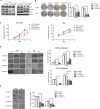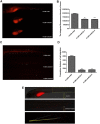SOX5 predicts poor prognosis in lung adenocarcinoma and promotes tumor metastasis through epithelial-mesenchymal transition
- PMID: 29541384
- PMCID: PMC5834284
- DOI: 10.18632/oncotarget.22443
SOX5 predicts poor prognosis in lung adenocarcinoma and promotes tumor metastasis through epithelial-mesenchymal transition
Abstract
Lung cancer is the leading cause of cancer-related death worldwide. Epithelial-mesenchymal transition (EMT) promotes lung cancer progression and metastasis, especially in lung adenocarcinoma. Sex determining region Y-box protein 5 (SOX5) is known to stimulate the progression of various cancers. Here, we used immunohistochemical analysis to reveal that SOX5 levels were increased in 90 lung adenocarcinoma patients. The high SOX5 expression in lung adenocarcinoma and non-tumor counterparts correlated with the patients' poor prognosis. Inhibiting SOX5 expression attenuated metastasis and progression in lung cancer cells, while over-expressing SOX5 accelerated lung adenocarcinoma progression and metastasis via EMT. An in vivo zebrafish xenograft cancer model also showed SOX5 knockdown was followed by reduced lung cancer cell proliferation and metastasis. Our results indicate SOX5 promotes lung adenocarcinoma tumorigenicity and can be a novel diagnosis and prognosis marker of the disease.
Keywords: EMT; SOX5; lung adenocarcinoma; prognosis.
Conflict of interest statement
CONFLICTS OF INTEREST The authors declare that they have no conflicts of interest.
Figures






References
-
- Siegel RL, Miller KD, Jemal A. Cancer statistics, 2015. CA Cancer J Clin. 2015;65:5–29. https://doi.org/10.3322/caac.21254. - DOI - PubMed
-
- Chen W, Zheng R, Baade PD, Zhang S, Zeng H, Bray F, Jemal A, Yu XQ, He J. Cancer statistics in China, 2015. CA Cancer J Clin. 2016;66:115–32. https://doi.org/10.3322/caac.21338. - DOI - PubMed
-
- Miller KD, Siegel RL, Lin CC, Mariotto AB, Kramer JL, Rowland JH, Stein KD, Alteri R, Jemal A. Cancer treatment and survivorship statistics, 2016. CA Cancer J Clin. 2016;66:271–89. https://doi.org/10.3322/caac.21349. - DOI - PubMed
-
- Chen K, Zhou F, Shen W, Jiang T, Wu X, Tong X, Shao YW, Qin S, Zhou C. Novel mutations on EGFR Leu792 potentially correlate to acquired resistance to osimertinib in advanced NSCLC. J Thorac Oncol. 2017 https://doi.org/10.1016/j.jtho.2016.12.024. - DOI - PubMed
-
- Chambers AF, Groom AC, MacDonald IC. Dissemination and growth of cancer cells in metastatic sites. Nat Rev Cancer. 2002;2:563–72. https://doi.org/10.1038/nrc865. - DOI - PubMed
LinkOut - more resources
Full Text Sources
Other Literature Sources
Molecular Biology Databases

